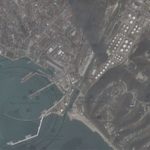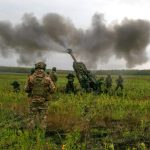Iraqi Security Forces (ISF) and Iranian-backed Popular Mobilization Units (PMUs) have ousted the Kurdish Pashmerga forces from key areas that they have expanded to throughout the anti-ISIS campaign: Mosul Dam, Kirkuk, Sinjar and the Nineveh plains. These events are relevant to comprehend the ongoing tensions within the anti-ISIS camp in Iraq, and subsequently Iran’s asserting geopolitical order. Erbil’s push for Kurdish independence was overly optimistic and led to the reversal of the Kurdistan Regional Government’s (KRG) extent to 2003 limits.
KIRKUK: A RED LINE
1. Just three weeks after the Independence referendum held by the Kurdistan Regional Government (KRG), which announced a secession of the region for Iraq, the situation has dramatically shifted. Throughout the past 3 years, the Kurdish Pashmerga and other militias have liberated significant ground from ISIS north in the country, which they later seized to expand the KRG. The most important location taken under Kurdish authority is the city of Kirkuk and its oil rich surroundings. Since June 2014, when the Iraqi army deserted positions around northern Iraq in face of ISIS attacks, the opposition Patriotic Union of Kurdistan (PUK) and the Pashmerga assumed the administration of Kirkuk, triggering wild protests from both Ankara and Baghdad.
2. Kirkuk is an energy hub, the oil fields around it amount to 12% of Iraq’s potential, and it’s also well connected to export markets via the Ceyhan pipeline towards the city-port in Turkey with the same name. Taking into consideration that KRG accounts for 17% of Iraq’s oil deposits, seizing Kirkuk would almost double Erbil’s capacity on the energy market, and provide more revenue, badly needed for an emerging war-torn state.
3. This dispute is far from being new, Kirkuk is also considered as the “Kurdish Jerusalem”, and a symbol of resistance against the Ba’ath regime, that sought to social engineer the area. Between 1970 and 2003, hundreds of thousands of Kurds were expelled further north, making space for Arab Sunnis to take their place and change the local demographics. The An-Anfal campaign of Hussein’s regime that killed around 182,000 Kurds is another brutal display of a perpetual persecution by the Baghdad establishment.
5. Due to the Arabization process, and the lack of credible public records during the Ba’ath regime, the census of 1957 is considered the least politicized which said that Kirkuk was 48.3 percent Kurdish, 28.2 percent Arab, and 21.4 percent Turkmen.
6. The Turkmen remained a persistent community that also pose an opportunity for Turkish ventures in the ex-Ottoman province of Nineveh, now part of Iraq. This serves as a useful premise for the government in Ankara to promote cultural diplomacy and apply its military leverage in Syria and Iraq, as seen in the past years.. The Kurdish community while more reduced in numbers that in 1957, is still assessed to be consistent, while some of the Arabs are believed to have successively left the city and region in the post-2003 era fearing persecution. However, this does not mean that the demography tilted into the Kurdish favor.
THE KURDS OVERPLAYED THEIR CARD
7. Beyond the historical disputed character of the Kirkuk area, it was the Independence referendum vote organized by the authorities in Erbil that prompted a steadfast counter-reaction. Recent diplomatic threats, and military drills (some of them with Turkey) set the stage for a full-on intervention on October 16th, by Iraqi Security Forces (ISF) and Shia’s militias (Popular Mobilization Units/ PMUs) sponsored and trained by Iranian Revolutionary Guards Corps (IRGC) to storm the city.
8. In a desperate attempt to withhold, the President of the KRG, Masoud Barzani, and the Pashmerga allowed the outlawed terror separatist terror group, PKK, to assert a public, frontline position in a bid to defend it. While reports and photos confirm the premise, Pashmerga’s official position is contrary, mentioning that the embedded and mentioned fighters are merely ‘PKK sympathizers”. Regardless of that, it was a dangerous gamble, since Turkmen officials and militias called upon Turkey to intervene and protect the community for PKK. Inherently, it was only the Iraqi intervention that stopped a potential Turkish one.
9. With few shots fired, and even less casualties inflicted on both sides, the Pashmerga and PKK retreated to the outskirts of the city, while ISF and allied militias were sweeping Kirkuk and taking down billboards of Masoud Barzani and burning KRG flags. Many Kurds took the road of exile towards Erbil or Suleymaniah blocking the main highways, as the Pashmerga watched powerlessly and shocked how they lost their crown jewel in under 24 hours. CENTCOM managed to ground Iraqi air assets, by scrambling jets that patrolled the skies of Kirkuk, and almost instating an unofficial no-fly zone. Moreover, the U.S.-led Coalition ‘Inherent Resolve’ called on all parties to avoid escalation.
10. The political establishment in Erbil held the PUK leaders on the ground responsible for this disaster after ordering the Pashmerga to stand down and evacuate the city. To make things even worst, the ISF, PMU cohort took and are currently still taking, the rest of the expanded KRG territory during the past years in the anti-ISIS campaign, namely: the self-proclaimed autonomous Yazidi Shengal (mount Sinjar), Mosul Dam, Bashiqa (where Turkey hosted a training camp) and other locations around the Nineveh plains. But this is not only a disaster for the Kurds, but for the U.S. as well.

BETWEEN A ROCK AND A HARD PLACE
11. The near non-combat setting in Kirkuk was also a result of negotiations in the city between IRGC’s al-Quods branch and the Pashmerga. Eqbalpour, an Iranian officer who works closely with Qasem Soleimani (al-Quds commander) offered Pashmerga a chance to surrender. He took out a map of the area and spread it out in front of his Kurdish counterparts. “This is our military plan. We will hit you tonight from three points — here, here and here,” he said, and then left the meeting with his entourage.
12. U.S. forces were based outside Kirkuk at the K-1 air base, and played no role in these event. Washington failed to contain the tensions between Baghdad and Erbil and limiting Iran’s involvement in Iraqi affairs. Whether this is the result of an intelligence failure, of bad decision making, or simply due to the situational constraints, it is unknown.
13. Accordingly, Baghdad forced the Kurds into an agreement to withdraw back to the 2003 agreed borders, basically nullifying their efforts in the past 3-4 years. The effort was a success for both Baghdad, which projected sovereignty and force over the entire Iraqi territory, and Iran, which prevented the disintegration of its neighboring state.

Iraqi Security Forces in Kirkuk’s governor office.
14. The lack of a major Turkish intervention is at least surprising, especially given the symphony of common military drills held with the Iraqi Security Forces at the border. Even though limited elements did cross the border in anti-PKK operations in northern Iraq.
15. Any time stall is a direct benefit for ISIS. The terror group still controls several villages, and small to medium cities along the Euphrates River Valley in Syria’s Deir ez-Zor province, Iraq’s Anbar region, several disperse pockets in Hama (central Syria), and holds informal control over directly linked Salafist groups operating in Rural Damascus (Yarmouk camp), or Quneitra, near Israel.
A CREDIBLE DETERRENT
16. The Kurdish independence dream in Iraq crumbled before it even began. Surrounded by hostile and anxious opponents, and supported by pragmatic overseas allies, the Kurds didn’t stand a chance. More so given the naïve and hasty referendum, that had no chance to stand without military backing. The Iraqi Security Forces (ISF) gave the Pashmerga something to fear, a credible deterrent aimed at prevent similar outbursts in the future .
17. Turkey and Syria hope, that their own Kurds also learned a lesson. The United States, unable to contain its two divergent allies was completely isolated in the process, and witnessed again the extent of Iranian dominance in Iraq. Many critics argue that Washington intentionally stood idle and left the Shi’a militias steal the show.

Iraqis tear down Barzani’s independence billboard in Kirkuk city.
18. We assess that U.S. constraint was aimed at maintaining Iraq’s territorial integrity and at appeasing Baghdad’s demands. Furthermore, the ISF/PMU operation in Kirkuk did not pose an existential threat to the KRG and only affected the disputed peripheral territories. As long as the Iraqis and PMUs don’t decide to attack Erbil, or Suleymaniah, or attempt to subjugate the entirety of the KRG as a whole, then a U.S. intervention is highly unlikely and unnecessary. Should the showdown continue, Iran and Da’esh (ISIS) will be the main beneficiaries.
19. If the Kurdish commanders want to avoid repeating the mistakes from Kirkuk, they should work towards unifying their command & control structures, improve capabilities and modernize their quasi-militia-like structure.
Further reading on topics mentioned in the text and directly relevant to the situation at hand: ‘For Dust and Rubble: Iranian ambitions on the Syrian-Iraqi border’; and ‘Fury in Ankara, Anxiety in Erbil, Distress in Baghdad: Sinjar declares autonomy amid Kurdish Independence vote’.
Founder of T-Intelligence. OSINT analyst & instructor, with experience in defense intelligence (private sector), armed conflicts, and geopolitical flashpoints.





